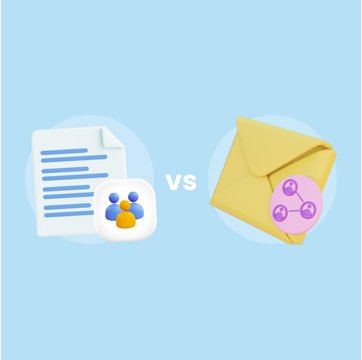Distribution List vs. Shared Mailbox: What Are the Differences?

Table of contents
Businesses, big and small, heavily rely on email for communication. And so, teams today rely on having a common inbox to streamline their interactions and ensure no message slips through the cracks.
While the common inbox concept is widely embraced, there are two popular ways to manage these inboxes: distribution lists and shared mailboxes. Both strive to amplify team communication, yet they have their own unique mechanisms and benefits.
To choose wisely, it’s essential to grasp the difference between the two and ascertain how they can best serve and facilitate your team’s communication dynamics.
In this guide, we’ll break down the “distribution list vs. shared mailbox” debate in simple terms, so you know exactly what’s what. Whether you’re a business owner, an employee, or just someone curious about email management techniques, we’ve got you covered.
Table of Contents
- What is a Distribution List?
- What is a Shared Mailbox?
- Key Differences Between Distribution List and Shared Mailbox
- Distribution List vs. Shared Mailbox: Pros and Cons
- Choosing the Right Option for Your Business
- Final Thoughts
What is a Distribution List?
A distribution list is a collection of email addresses grouped under a single email ID. When an email is sent to the distribution list’s address, it is automatically forwarded to all the email addresses contained within that list, allowing for efficient communication to multiple recipients simultaneously. In short, it’s a method that facilitates one-to-many communication.
For example, if you have to make a company-wide announcement, you can create a distribution group including email accounts of all employees. Instead of emailing each employee, you can send one single email to this distribution list (call it ‘All Employees’),and everyone gets the same message.
Benefits of Using a Distribution List:
- Efficiency: With distribution lists, you send one email to many people. There’s no need to type in multiple addresses.
- Consistency: Everyone gets the same message at the same time. No room for error.
- Organization: With lists, you can categorize communications. For example, you can create one for project updates, another for company-wide announcements, and so on.
What is a Shared Mailbox?
A shared mailbox, also known as a shared inbox, is a single email inbox that multiple users can access. In a shared mailbox, users can collaboratively read, respond, and organize emails in a single centralized location. This method facilitates one-to-many and many-to-one communication.
For example, a business might use a shared mailbox like “[email protected]” for all their support-related communication. Whenever a customer sends an email to [email protected], the email arrives in a common inbox from where an agent can pick up the email and respond to it.
Benefits of Using a Shared Mailbox:
- Team Collaboration: Everyone can see all the emails arriving inside a shared mailbox. This drives transparency and visibility into who is working on what email.
- Efficiency: Tasks like delegating, tracking, and managing group emails become streamlined with a shared view.
- Quick Service: For teams handling customer service, HR, or finance inquiries, a collaborative inbox like a shared mailbox ensures that they can provide faster, consistent responses.
Key Differences Between Distribution List and Shared Mailbox
Let’s break down the primary differences between distribution lists and shared mailboxes.
| Parameters | Distribution List | Shared Mailbox |
| User Experience and Accessibility | Email to one address; it auto-forwards to all recipients in the list. No direct shared access. Facilitates one-to-many communication. | Centralized mailbox; multiple users can read and respond to emails. Facilitates both – one-to-many and many-to-one communication. |
| Purpose and Usage Scenarios | Ideal for mass communications like newsletters, notifications, or announcements. | Best for teams like customer support or finance, where multiple people need access to emails. |
| Management and Administration | Managed by a list admin, adding/removing recipients as needed. | Manager by shared inbox admin/moderator; requires setting of permission to access emails. |
| Storage and Archiving | Emails stored in each recipient’s inbox. Archiving is individualized. | Central storage; when emails are archived or deleted, the same is reflected for all users. |
| Security Considerations | Risks include sending emails to outdated or wrong lists; Limited security features. | Higher control with user permissions. |
1. User Experience and Accessibility
When it comes to a distribution list, it’s similar to any email address. The only difference is that any email message sent to this ID reaches multiple recipients – in their respective inboxes.
On the other hand, a shared mailbox functions like a common mailbox. Multiple team members can access, read, and respond to emails that arrive in it. It’s a great way to collaborate on email with your colleagues and other internal teams. A Gmail shared inbox also drives transparency because everyone can see all incoming emails..
For example, if you want to send a monthly newsletter, you can use a distribution list – this ensures all relevant stakeholders get the same information (newsletter, in this case).
But when it comes to managing customer communication (eg: requests and issues),a shared mailbox is a better option. It helps your support team have full visibility into all incoming messages and assign and track all of them till the point of resolution.
2. Purpose and Usage Scenarios
Distribution lists are optimal when the primary goal is to disseminate information. Think of mass announcements or newsletters. Such communication that is meant for broadcast can be sent through distribution lists.
Shared mailboxes are meant for collaboration purposes. When a team needs to manage, delegate, and work together on email queries, shared mailboxes are your go-to option.
For instance, imagine launching a new product. A distribution list can inform all employees about the launch, while a shared mailbox can efficiently help handle customer feedback and inquiries about the launch.
3. Management and Administration
Managing a distribution list involves adding or removing recipients. There’s also the task of ensuring the list remains updated as team members come and go.
With managing shared mailboxes, the challenge lies in organizing emails inbox , setting permissions, and ensuring smooth collaboration. It might involve designating specific emails to team members or categorizing emails based on their nature.
To explain this better, here’s an example. In an HR department, distribution lists might need regular updates as employees join and quit on a regular basis. However, a shared mailbox used for recruitment should be able to categorize communication based on several types – job roles, interview stages, and more.
Streamline all HR communication within Gmail
4. Storage and Archiving
Both distribution lists and shared mailboxes use the email server’s storage. However, while emails sent to a distribution list get stored in individual recipients’ inboxes, emails in a shared mailbox reside in one central location, accessible to all, unless you set permissions.
Archiving practices differ too. In shared mailboxes, once an email is archived or deleted, the change is reflected for everyone. For distribution lists, users manage their individual email archives.
5. Security Considerations
Distribution lists, in essence, are about one-to-many communication, which is why there’s a risk of sending sensitive information to the wrong list or outdated recipients.
Shared mailboxes emphasize collaboration. Here, security concerns might revolve around granting access or permissions. Ensuring only relevant team members can view or act on specific emails is crucial.
For example, if a company’s finance team uses a shared mailbox, stringent permissions ensure that only authorized personnel access sensitive financial data.
Distribution List vs. Shared Mailbox: Pros and Cons
Let’s explore the advantages and challenges of distribution lists and shared mailboxes.
Advantages of Using a Distribution List
Business communication often necessitates tools that streamline processes and improve efficiency. One such indispensable tool is the distribution list. Here’s a more in-depth look into its strengths:
- Efficient Broadcasting – One of the standout features of a distribution list is its capability to broadcast messages to masses. With just one click, a message is sent to every member of the list, ensuring immediate dissemination of information.
For example, when rolling out a new company-wide policy, businesses can’t afford delays. A distribution list ensures that whether a team comprises 10 or 1000 members, everyone receives the update simultaneously. So, when a company wishes to circulate important announcements, the distribution list becomes the hero, ensuring every corner of the organization is reached promptly.
- Simplified Communication – Remembering or manually selecting numerous email addresses is not just time-consuming but also prone to errors. Distribution lists eradicate this, presenting a single point of contact.
For example, HR departments handle vast arrays of diverse topics. Consider the annual health checkup reminders or the introduction of new benefits. By employing a distribution list, they can ensure the right information reaches the right set of employees without the fuss. No more missing out because of a forgotten email address or a misspelled name.
- Tailoring Communication for Precision – Not every message is meant for everyone. Sometimes, communication needs to be tailored, segmented, and specific. Distribution lists shine in this aspect. They allow for the creation of specialized groups, ensuring that messages go to the right email recipients.
Consider this example. Different teams have different objectives and KPIs. While the “Sales Team” might be keen on monthly sales figures, the “Tech Department” could be more aligned with software updates or maintenance schedules. In such cases, crafting separate distribution lists, such as for “Sales Updates” and “Tech Updates,” empowers businesses to send pinpointed, relevant communications. It ensures the Sales team isn’t wading through tech updates and the IT team isn’t bogged down with sales targets.
Recommended read: 23 Email Management Best Practices and Tips
Cons of Distribution Lists
While distribution lists serve as vital tools in the organizational communication toolbox, they are not without their challenges. Being aware of these potential pitfalls can help businesses use them more judiciously.
- Lack of Two-way Interaction – Distribution lists are fantastic for broadcasting, but they inherently create a one-directional flow of information. This structure can sometimes hinder open dialogue and foster miscommunication.
Let’s imagine a scenario where a company sends out an important policy update. An employee, upon reading, finds an ambiguity. They reply, seeking clarity. However, that query reaches only the sender. This means other employees with the same question remain in the dark, possibly leading to a flood of similar questions or, worse, misunderstandings about the policy. The essence of collaborative feedback gets lost, and opportunities for quick, collective clarifications are reduced.
- Maintenance Overhead – Distribution lists aren’t “set it and forget it” tools. They demand regular maintenance to stay relevant, which can become a time-consuming task, especially in dynamic environments.
For instance, in an ecosystem of a growing startup, roles evolve, and teams expand. New members come on board, and some depart. This flux necessitates that someone constantly oversees all distribution lists, updating them to reflect these changes. Neglecting this task might mean a new team member remains uninformed about crucial announcements or a departing member continues to access internal communications.
- Potential for Oversights – Human errors or oversight in managing distribution lists can lead to communication blind spots. These unintentional misses can have ramifications ranging from minor confusion to significant security concerns.
Let’s say an organization decides to send a confidential financial report to a distribution list, assuming it’s only accessible to the current finance team. However, due to oversight, an ex-finance team member, who has since transitioned to a different department or even left the company, is still on the list. This scenario can lead to unintended sharing of sensitive information, posing risks to data integrity and security.
Benefits of shared mailbox
Shared mailboxes emerge as a beacon of collaboration in businesses. Let’s delve deeper into the manifold advantages they bring to the table.
- Team Transparency – A shared mailbox is more than just a communication tool; it’s a collaborative space. With everyone having access to the same pool of emails, it eliminates the silos that often fragment team communication. This shared view promotes collective understanding, ensuring everyone is aligned.
Picture a scenario where a key client sends in feedback. Instead of this email lying in one individual’s inbox, waiting for them to take action, it lands in a shared space. Now, every team member can view it. This transparency allows a sales representative to take note, a product manager to consider potential improvements, and a customer support executive to reach out and acknowledge the feedback. This way, the client feels heard, valued, and attended to in a comprehensive manner.
- Consolidated Responses – Nothing can be more confusing for a client or customer than receiving multiple, differing responses from the same company. A shared mailbox minimizes this risk by providing a unified platform where responses can be drafted, reviewed, and harmonized before dispatch.
Suppose a business receives an intricate query from a prospective client seeking details on a product’s features, pricing, and implementation. With a shared mailbox, the sales team can draft the primary response, the tech team can chime in with specific feature details, and the billing department can ensure accurate pricing. This collaborative effort ensures that when the client receives the reply, it’s comprehensive, consistent, and clear.
- Real-time Tracking and Delegation – The dynamic nature of shared mailboxes allows for emails to be more than just messages; they become actionable items. With features like assigning, categorizing, and setting statuses, managing communications transforms into a streamlined process.
For businesses that deal with high volumes of customer inquiries, like a support team, the influx of email queries can be overwhelming. However, with a shared mailbox, these queries can be instantly assigned to respective teams. A technical issue can be delegated to the tech expert, while a billing question goes to the finance team. Further categorization, like marking tickets as “Urgent” or “Resolved,” ensures that nothing slips through the cracks and customers receive timely, accurate assistance.
Potential Challenges with Shared Mailboxes
While shared mailboxes have emerged as collaborative powerhouses in the business communication landscape, they come with their set of challenges.
- Risk of Collision – The very essence of a shared mailbox, its collaborative nature, can sometimes be its Achilles’ heel. When multiple team members have access to the same set of emails, there’s an inherent risk of overlapping actions if coordination isn’t meticulous. For such situations, it’s important to set up collision alerts in the shared mailbox.
Consider a scenario where a customer emails regarding a product feature. Two team members independently draft responses. The customer, in turn, receives two distinct answers, leading to confusion and possibly denting the company’s image. Such scenarios underline the importance of clear delegation and real-time communication within teams. For instance, Hiver’s collision alerts while using shared inboxes become really helpful. You get real-time visual alerts when one is drafting a response to a mail. Also, this feature disables the option to edit a draft for other users when one user is already working on an email response.
- Privacy Concerns – In a shared environment, striking a balance between collaboration and privacy can be tricky. While the shared mailbox aims to promote transparency, not every piece of information is meant for all eyes.
Imagine an email containing salary negotiations with a prospective hire or a confidential financial forecast. Such sensitive data, if viewed by unauthorized personnel, can lead to unintended consequences, both for the individuals involved and the company at large. It accentuates the need for robust permission settings, ensuring only relevant stakeholders can access specific email threads or categories.
- Management Complexity – A shared mailbox, especially for large teams or growing companies, demands meticulous management. From setting user permissions to categorizing emails and ensuring everyone adheres to best practices, the backend work can be daunting.
For example, as companies scale, new members join teams, and roles evolve. This dynamic nature means that access levels granted today might not be relevant tomorrow. A team member transitioning from sales to product management might require different shared mailbox permissions. Regular audits, training sessions on protocols, and periodic reviews become essential to ensure that the shared mailbox remains a tool of efficiency, not chaos.
Recommended read: Everything you need to know about Shared Inbox
Choosing the Right Option for Your Business
Although most email clients, such as Microsoft or Gmail, offer some shared mailbox and distribution list functionalities, it is important to understand what your business requires. Every business is unique, and so are its communication needs. The decision between opting for a distribution list or a shared mailbox (or even both) hinges on multiple factors. Let’s explore how to make an informed choice tailored to your business’s specific requirements.
Assessing Your Business Communication Needs
Before diving into the tools, it’s paramount to have a clear understanding of what you need them for.
- Volume and Nature of Emails: Does your business primarily send out announcements and newsletters to a group of people, or does it revolve around handling customer queries, feedback, and collaborative tasks? A distribution list might suffice for the former, while a shared mailbox excels at the latter.
- Team Collaboration: If your business necessitates multiple team members working on the same emails, a shared mailbox is a more natural choice.
- Feedback Loop: Do you need a two-way communication channel where responses and discussions are visible to a group? A shared mailbox offers this transparency.
For instance, a startup in its early stages, focusing on building a community, might prioritize newsletters, notifications, and announcements, making distribution lists apt. But as it scales, handling customer feedback and support might necessitate a shared mailbox.
Cost Implications
The financial aspect is always a consideration:
- Initial Setup Costs: While both options may come with setup costs, shared mailboxes, especially with features aligning with your needs, might require more initial investment.
- Maintenance: Distribution lists generally have lower maintenance costs. However, shared mailboxes, given their complexity and features, might incur ongoing costs, especially if additional functionalities are added.
- Scaling: As your business grows, so might the costs. Expanding distribution lists or adding more users to shared mailboxes can affect your budget.
For instance, a medium-sized enterprise looking to foster inter-departmental collaboration without a significant financial outlay might start with a basic shared mailbox. As ROI becomes apparent through improved efficiency, they can then invest in more advanced features.
Integration and Compatibility
No tool operates in isolation. How well your chosen option integrates with other business tools can impact productivity:
- CRM Integration: Especially for sales and support teams, a seamless flow between the shared mailbox and Customer Relationship Management tools can be invaluable.
- Project Management: If your business relies heavily on collaboration tools like Trello or Asana, check how well the shared mailbox or distribution list integrates.
- Automation and Bots: Modern communication often involves automated email response or bots, especially in initial customer interactions. Ensure that your chosen option supports and integrates with such functionalities.
One such use-case can be if an e-commerce platform receives numerous customer queries daily. If their shared mailbox integrates seamlessly with their CRM, it can automatically categorize queries, assign them to specific agents based on customer history, and even set follow-up reminders.
Recommended read: 7 Customer Service Tools to Integrate with Google Workspace
Final Thoughts
The choice between distribution lists and shared mailboxes hinges on specific business needs. While distribution lists are ideal for broadcasting messages to a wide audience without fuss, shared mailboxes shine in real-time collaboration, ensuring that teams operate in harmony and customers receive cohesive responses.
If your business is leaning towards collaborative communication, you should check out Hiver. Hiver’s shared mailbox feature stands out because of its easy-to-use interface. It not only streamlines team interactions but also integrates seamlessly with other tools, ensuring that communication is efficient and comprehensive.
Moreover, Hiver’s functionalities are built to work on top of Gmail so that you do not have to migrate to any other platform for collaboration. Interesting, isn’t it?

































